When regular rhythm is disturbed due to issues like jet lag or bright light, the circadian rhythm throws us out of gear. Also, our circadian rhythm changes as we grow old. By paying attention to the circadian rhythm and its impact on us we can ensure a better health.
Many times we feel energised and tired every day at particular times. This is due to a phenomenon called circadian rhythm (bio rhythm). Our body has a 24-hour biological clock that controls our actions of sleeping and being alert. It is also known as our sleep/wake cycle.
For many of us the biggest dip in energy happens in the middle of the night sleep (2:00am to 4:00am) and just after lunch time (1:00pm to 3:00pm), but varies from person to person. Impact of circadian rhythm is profound when we are sleep-deprived, leading to bigger swings of sleepiness and alertness. Circadian rhythm is controlled by hypothalamus (a part of our brain).
Outside factors like bright light and darkness impact it further. When it is dark at night, our eyes send a signal to the hypothalamus that it is time to sleep. In turn, our brain sends a signal to our body to release melatonin, a substance that makes our body feel tired, so we start feeling sleepy. Typically, circadian rhythm tends to coincide with the cycle of day time and night time. This also is the reason why working in night shifts or for extended time can disturb our sleep cycle.
Regular sleep habits keep the circadian rhythm fine. When regular rhythm is disturbed due to issues like jet lag or bright light, the circadian rhythm throws us out of gear. Also, our circadian rhythm changes as we grow old. By paying attention to the circadian rhythm and its impact on us we can ensure a better health.
How our brain responds to light
Our biological clock controls our circadian rhythm. There is a master clock in the brain that co-ordinates and synchronises all the body clocks. The master clock comprises a group of nerve cells in the brain, each about the size of a grain of rice, called Supra Chiasmatic Nucleus (SCN). Fig. 1 shows how our eyes and brain recognise colours.
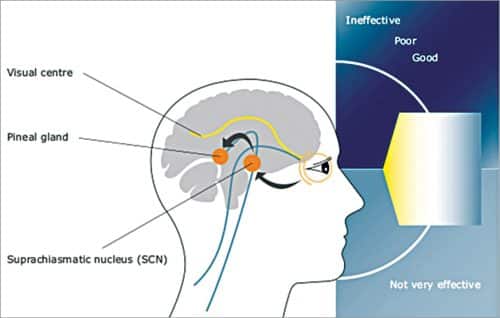
The SCN contains about 20,000 nerve cells and is in the hypothalamus (a small region of the brain located at the base of the brain, near the pituitary gland), just above where the optic nerves from the eyes cross. SCN controls the production of melatonin, a hormone that makes us sleepy. Melatonin is very important for a good health as it is an antioxidant, a cancer fighting substance, and an anti-ageing hormone, thus very crucial for our health.
Retina in the human eye contains three photoreceptors that are essential for vision. As shown in Fig. 2, these are:
- Cones that sense colours
- Rods that sense dim lights
- Ganglion cells that sense blue light
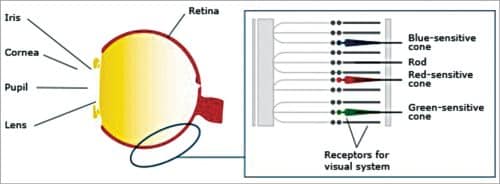
When the eye sees an image, SCN receives information about incoming light because it is located just above the optic nerves. SCN relays information from the eyes to the brain. So, when the eyes see less at night, SCN tells the brain to produce melatonin, which makes us sleepy.
This melatonin production is in the pineal gland and its production varies with the time of day and also the colour of the light. The ganglion cells (which are sensitive to blue light) send signals to the brain and regulate the hormone production.
When light is switched on suddenly in the middle of the night, it leads to ‘melatonin block,’ which stops melatonin production, leading to fatigue during the day. If the body does not produce enough melatonin, it results in blood pressure (BP).
This increase in BP combined with suppressed cortisol (a hormone responsible for managing stress response and alertness) when the individual is under some kind of stress could lead to heart diseases. Repeated interruption of melatonin production during nights can result in sleep disorders leading, especially, to lesser sleep.
At daybreak, the same SCN triggers the production of other hormones like:
- Dopamine, needed for pleasure, alertness, and muscle co-ordination
- Serotonin, which controls our impulses and carbohydrate cravings
- Cortisol, needed for stress response and alertness. Remember caffeine in the morning interferes with the production of cortisol (opposite of what we think!)
- Melatonin, which leads to drowsiness, good sleep, lower body temperature, and lower blood pressure
Multiple research results have shown that the ambient light impacts circadian rhythm through three parameters, which are:
- Spectrum of the light
- Intensity of light
- Time of light getting switched on and off
By controlling these three parameters, circadian rhythm can be controlled and tuned for a healthy life. Research has shown that it is important to keep the circadian rhythm in balance, especially of paramedical workers like nurses, patients, and people who work in mines and submarines and so get very little exposure to natural light.
Since circadian rhythms plays a such a vital role, let us briefly look at these three parameters to understand how the light impacts humans and how human-centric lighting can be used for better living.
Spectrum
We all know, white light has seven primary colours. Visible light’s wavelength is between 380 and 780nM. Fig. 3 shows how the light spectrum is distributed in a typical day.
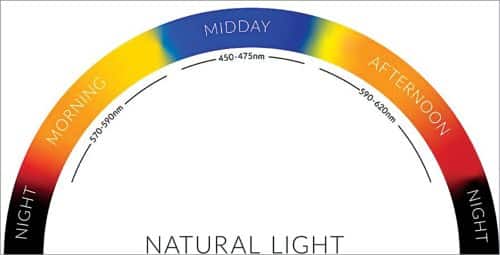
Blue wavelength in the natural light is the most biologically active wavelength. Blue light can be produced by selecting a cool white light source. Our eye has red, blue, and green cones to sense colours (see Fig. 2). Interestingly, we do not perceive all the colours equally. Colours in the region of 555nM wavelength (yellow-green in the visible spectrum) are sensed the brightest.
Ironically, biologically impacting regions are in the wavelength of 480nM and this corresponds to blue light. As we can see, midday light has the maximum blue light, which has a major impact on circadian rhythm. White light is classified into two categories, which are:
- A white light that has more blue component is called cool white. Fig. 3 shows that midday light has more blue, which leads to lower melatonin secretion and keeps us energised and alert.
- A white light that has less blue component is called warm white, which we can see in the early mornings and evenings.
Intensity
Second parameter that impacts us is the intensity of the light. Intensity is typically measured in Lux. Studies show that an intensity of 300 to 400 Lux at the eye level, or 1,000 Lux at the work plane level (our working table level), will have a positive impact on our bio rhythm or circadian rhythm.
Unlike the conventional bulbs, an LED light source can be controlled by the current flowing through it. Higher the current, higher the intensity! This ability to control the intensity of light helps the growth of human-centric lighting business.
Timing
Third aspect that impacts us, along with colour and intensity, is the time when the lights are switched on and off. Adjusting the intensity of the light, along with the colour at different times of a day, can create a healthy environment for us due to impact of light on our circadian rhythm. For example, excess light in the evening can reduce the secretion of the melatonin and thus lead to lack of sleep, which can cause multiple health issues.
Using LEDs for a healthy life
With the background on the circadian rhythm and characteristics of natural light let us learn how lights can be used to impact human biological rhythm in a positive way. Human-centric lights became popular with the emergence of LED lights and their ability to control the colour, intensity, and timing with ease.
The top-most factor that impacts the human-centric lighting is the spectrum of the light as colour is critical for impacting the circadian rhythm. Change of colour was difficult with conventional light sources like incandescent bulbs and compact fluorescent lamps. This challenge was overcome once the LED based light sources became common, accelerated by the fact that prices of LED lights have bottomed out. This has helped in building low-cost human-centric lighting systems that impact our circadian rhythm positively, leading to a healthier life.
In human-centric lighting, first blue-rich, high-intensity light is produced in the early morning until midday, tapering off towards 4pm in the evening. After 4pm, only 3,000 degrees Kelvin light (typically warm white) is produced, which is reduced in intensity until bedtime.
To choose the right LEDs we need to take care of a parameter known as correlated colour temperature (CCT), which defines the colour appearance of a white LED in degrees Kelvin (K). A warm light is around 2700K, moving to neutral white at around 4000K, while a cool white is at 5000K and beyond.
Basics of human-centric lighting
Let us now see the basic architecture of human-centric lighting system, which is based on a mixture of cool white and warm white lights. It is achieved using a simple PWM control with cool white and warm white LEDs that are driven by inverted PWM waveforms. This essentially means when the cool white LED is glowing bright and warm, white LED will be glowing dim (in proportion to the PWM on and off times).
Fig. 4 shows how both types of LEDs (warm and cool white) are connected to generate human-centric lighting with a single control. Readers can experiment with a simple 555 timer based circuit to see how the system works. Please note, the LEDs are always driven by current sources and not by voltage sources. This means the PWM circuit should drive the current sources.
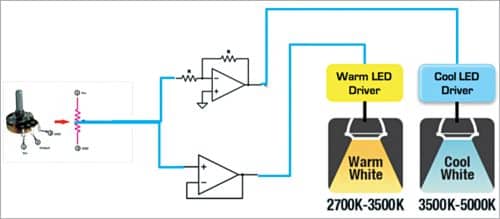
However, one challenge with PWM-driven LED lighting systems is that when a video is taken horizontal lines appear in the video. This is due to the LEDs that are switched on and off at PWM frequency, which does not synchronise with the camera’s frame rate. So to check whether the lights are PWM-driven or linear-current-driven, hold your mobile phone camera in video mode towards the LED light. If you see scrolling lines, the LED light is operating in PWM mode, and it is advisable to use a linear-current-driven LED for video recording.
Second important aspect is how the LEDs are positioned. Cool and warm LEDs are alternated so that the net output is mixed light. We get readymade modules from vendors that can be used directly as these have prepositioned LEDs. One such module is shown in Fig. 5. You can see the way warm and cool LEDs are positioned in the module (yellow and orange ones).
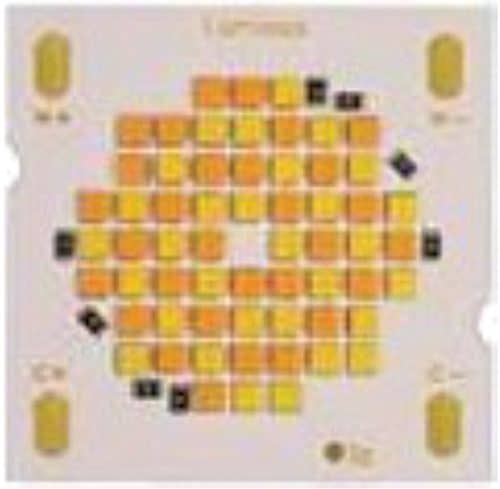
Last important aspect is the use of a diffuser in the light to merge/mix the warm and cool LED lights into one single light source. Today readymade human-centric lighting luminaires are available in different shapes and sizes, either with manual control or automatic control.
Essentials of human-control lighting
Human-centric/circadian rhythm lighting system for a large space like office or home essentially has two components:
- Human-centric/circadian rhythm lighting modules with controllable drivers
- Centralised control system for controlling the human-centric/circadian rhythm lighting systems
The systems can be implemented in three ways:
- Wired control using RS-485 or DALI protocols
- Wireless control where every luminaire has an RF interface (ZigBee/6LOWPAN/Bluetooth mesh) and can be controlled through that
- Power over Ethernet (PoE) powered luminaires, whose biggest advantage is that lighting system does not need separate main supply as the luminaire can be powered through the Ethernet cable. Also, the system becomes a part of the network infrastructure and is thus easy to manage and control.
Now let us look briefly at each of the controls for better understanding.
Wired system
Traditional human-centric/circadian rhythm lighting system can be easily controlled through wired connections with the use of wireline protocols like RS-485 or DALI (a protocol used for controlling stage lighting used in such lighting systems) protocols. This wired control is easy to implement as the existing lighting system can be upgraded to human-centric lighting with just the addition of control wiring and replacement of ordinary luminaires with human-centric luminaires. The system still needs zonal control gateways to integrate into the existing infrastructure. Fig. 6 shows the topology of a wired system.
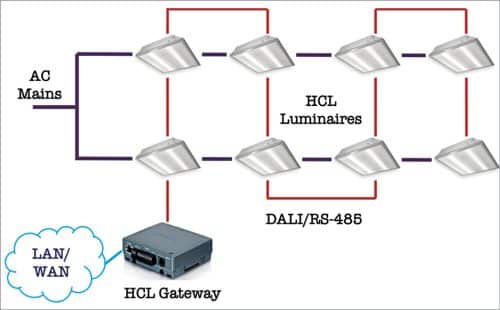
Wireless system
In the case of wireless control, the performance depends on the building environment in which the human-centric/circadian rhythm lights are used. In most office buildings one of the biggest challenges is that the lights are mounted on a false ceiling.
While wired solutions can be implemented through the space between the false ceiling and the roof, wiresless systems tend to have performance issues when used in these situations. Also, the wireless band is generic open ISM (industrial, scientific, medical) band and tends to be noisy. It gets disturbed by the environment, especially in industrial environments.
However, when a building is upgraded for human-centric/circadian rhythm system, the above two control systems work well as they are easy to implement. Fig. 7 shows a classic wireless human-centric/circadian rhythm system.
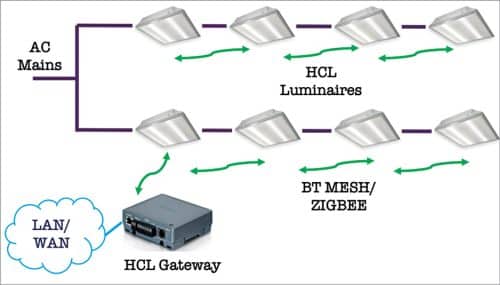
Conventional wireline protocols based systems require laying of new cables for controlling and in some cases the power lines too. At the same time, a wireless system does have less of installation issues but its performance is unpredictable. For a flawless system a reliable solution is needed.
Situations like this can be addressed through Power over Ethernet (PoE) standard. PoE uses the normally available twisted-pair Ethernet cables, which are readily available. It has the ability to control the lights along with supplying power through the same cable, which makes the system easy to implement, use, and maintain.
Introduction to PoE
Today’s Ethernet standard allows power to be carried to the end node in addition to the data at speeds ranging from 10Mbps to 1Gbps. A classic PoE connection looks as shown in Fig. 8.
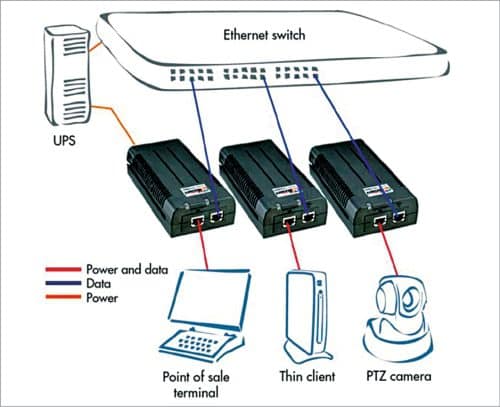
The configuration consists of PoE Ethernet switch, which has a PoE source node (PSE) that sources the power to the end node (PDE) (small black boxes). But as time progresses, most end nodes by default support built-in PoE-PDE support. This means only PoE powered Ethernet needs to be terminated in the equipment (no small boxes needed), which has the PDE function along with its networking port.
IEEE has defined a set of PoE standards whose major variations are in the delivery of power over the Ethernet cable. We need to remember that PoE standards are applicable only for the twisted-pair cable based version of Ethernet. Table 1 shows the different standards defined by IEEE and their power carrying capability.
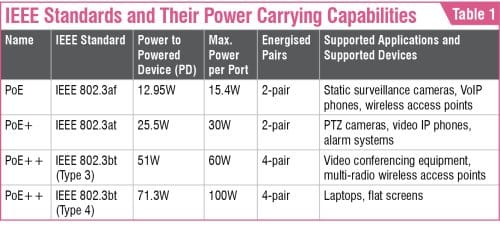
Fig. 9 shows the cable pairs used for the power distribution by the different PoE standards.
Table 2 shows the actual power at the source and power delivered at the node for better understanding of the real capabilities of different variations of the standards.


Functional blocks
With power handling capability of PoE ranging from 25W to 70W pretty much all the luminaires used in homes and offices can be easily implemented using PoE. A basic PoE lighting system has two major blocks, which are shown in Fig. 10.
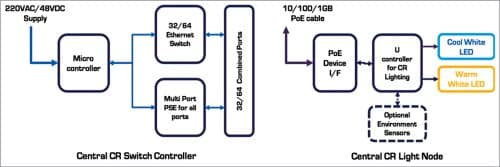
The first block is of central controller that performs following three functions:
- Acts as a central controller for controlling all the human-centric/circadian rhythm system in the building.
- Acts as a PoE source node along with an Ethernet switch to feed the power to the lights. The PoE powered human-centric/circadian rhythm switch can work with off-the-shelf Ethernet switches and associated components for 32 or 64 ports.
- Supplies power through the Ethernet cable (up to 100 metres maximum) for the lights to work.
The second block is of circadian rhythm light node that has PoE device interface chip with built-in DC/DC converter. It is managed by the microcontroller which receives commands from the PoE switch controller. Based on the commands it controls the warm and cool LED based lights to produce the right amount of stimulus based on programming, time of day, and location.
More complex systems can be equipped with environmental sensors including ambient light sensor to ensure correct amount of light is configured by correlating the internal lighting with the measured value and external light coming through the windows.
Advantages of PoE powered lighting
PoE is basically a power delivery mechanism using the existing Ethernet wiring for up to 30W end node consumption. For higher power levels CAT6E or equivalent are preferred. Some key advantages are:
- Separate power and control wiring are not needed in building which uses 20W troffer lamps (typical 2×2 false-ceiling-mounted square luminaries consuming 20 to 30W that are normally used in commercial environments).
- Since the power and the control are through the same cable, and normally most offices have wired building, implementing a human-centric/circadian rhythm system can be managed in the existing network environment.
- Since the lighting system has become part of the network, separate back-up for the lighting is not needed. Typically, office complexes have inverter as a backup for the lights till the generators take over. In the case of PoE based lighting this issue is taken care of as the network equipment is backed up through UPS and generators.
- With the central controls, lighting can be programmed through human-centric/circadian rhythm system and can also be used to optimise the lighting requirement based on the active presence of humans in the room.
S.A. Srinivasa Moorthy is Director Engineering Design, D4X Technologies Pvt Ltd






